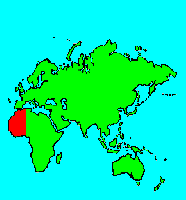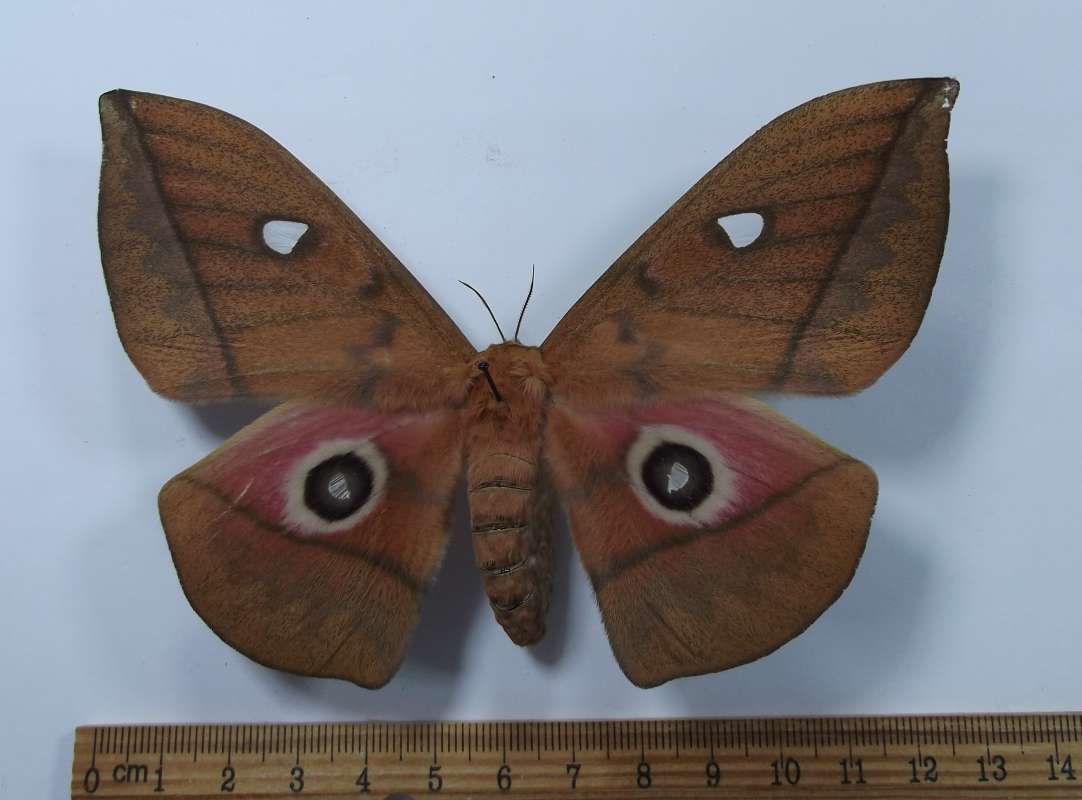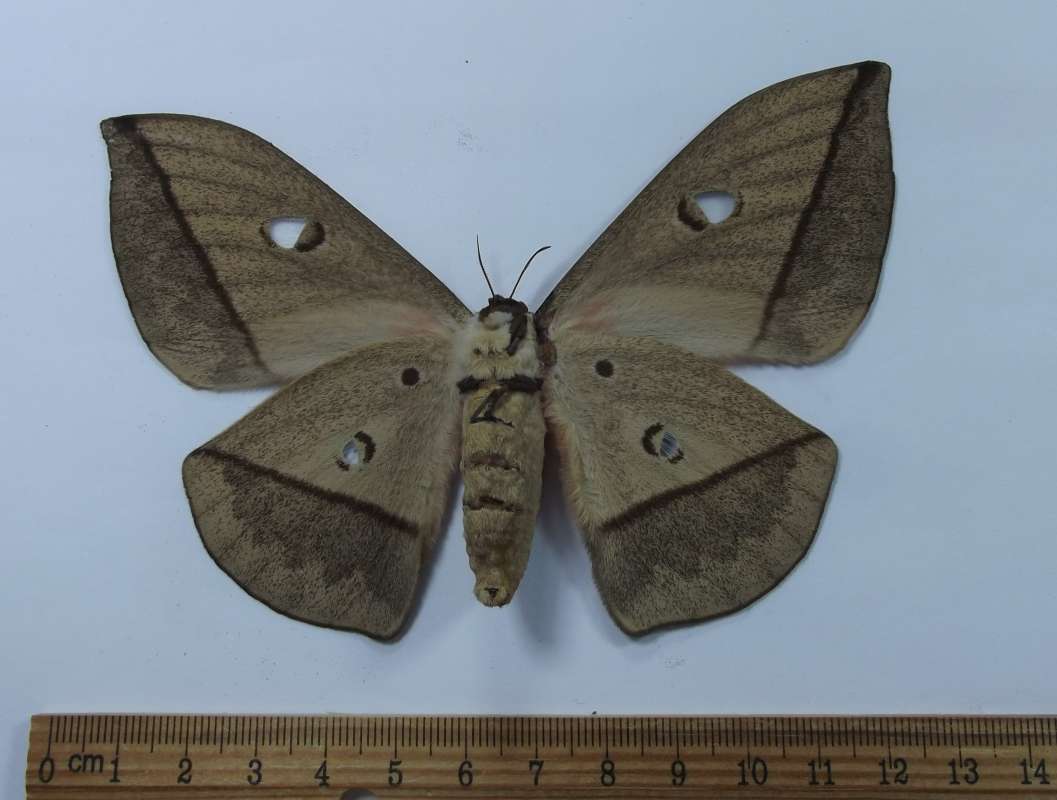SPECIES INFO
Lobobunaea acetes has a front wing length from body to wing tip of about 7.2 to 7.5 cm. We note that the L. acetes and L. niepelti species complex creates a complex taxonomic situation, that might someday end up as at least 4 different species. Pinhey notes this species is found in equatorial Africa.
This male form pictured herein is a smaller form with a small eyespot in the rear wing. This particular example has only an 11 cm wing spread. The front wings in this specimen are not very falcate.
D'Abrera pictures L. acetes as a larger form with a large rear wing eyespot covering about 33% of the rear wing with a very falcate front wing. D'Abrera also pictures L. melanoneura of West Africa as a smaller species with a rather small eyespot that fills only about 20% of the rear wing. His male specimen has a quite falcate front wing.
Perhaps this male specimen is related to L. melanoneura. The reddish color of the Niger female also might raise taxonomic questions.
Guinea is between Senegal and Ivory coast in the western coastal portion of West Africa.The African Saturnidae genus (Lobobunaea) contains some small, medium, large, and very large species. The following characteristics can help one identify members of the genus:
1) Dorsal Forewing: The forewing is usually falcate. (i.e. there is an indentation of the outer edge of the wing below the wing tip.)
2) Dorsal Forewing: There usually is a very well marked submarginal dark line along the outer edge of the wing.
3) Dorsal Forewing: The area beyond the dark line is usually lighter in color than the body of the wing.
4) Dorsal Forewing: With the exception of L. christyi, there normally is no eyespot, or if present, not very pronounced.
5) Dorsal Rearwing: The eyespot usually has a black, or sometimes just a dark center.
6) Dorsal Rearwings: The trailing edge of the rear wing is not usually uniformly rounded, but has a slight bend outward near the center. (This is not a tail, but a noticeable characteristic.)
This group comprises the majority of medium, large, and very large African Saturnidae. The genera Aurivilius, Buenopsis, Imbrasia, Lobobunaea, Melanocera, Pseudantheraea, Pseudobunaea, Nudaurelia, and others belong here. (We have spearated the Athletes, Eustera, and Gynanisa into a separate group.)
There is great confusion in the naming of these African species, and furthermore there is great confusion between several genera. Perhaps one of the most disputed is the relationship between the genera Imbrasia and Nudaurelia. For example, D'Abrerea in his 2012 revision of this group of African Satunids places the well known small yellow species, dione, as Nudaurelia dione. He thus also includes many other related species in the Nudaurelia genus. However, the well designed web site on Saturnidae from Germany places this species as Imbrasia dione. Naturally, they also include many other related species in this genus.
(D'Abrera reserves the genus Imbrasia for those (5 or so) species with tailed males. However, a comparison of the females of several of those five species with Nudaruelia melanops female will alert one to the problems between these two genera.)
Saturnid moths (family Saturnidae)are the giants of the moth world. They are usually characterized by their unique feather-like antennae. Males usually have larger antennae used to locate the females. Many species have transparent eye spots on their wings.
Typically, the males find the females upon emergence and copulate immediately. The United States government has frequently researched the sensing mechanism that permits the males to find the females in hopes of finding a military application.
Butterflies and Moths (Order Lepidoptera) are a group of insects with four large wings. They go through various life cycles including eggs, caterpillar (larvae), pupae, and adult. Most butterflies and moths feed as adults, but primarily do most of their growing in the larval or caterpillar stage. Also, most species are restricted to feeding as caterpillars upon a unique set of plants. In this pairing of insects to plants, there arises a unique plant population control system. When one plant species becomes too common, specific pests to that species also become more common and thus prevent the further spreading of that particular plant species.
Although most people think of the Lepidoptera as two different groups: butterflies and moths, technically, the concept is not valid.
Some families, such as Silk Moths (Saturnidae) and Hawk Moths (Sphingidae), are clearly moths. Other families, such as Swallowtail Butterflies (Papilionidae), are clearly butterflies, However, several families exhibit characteristics that appear to be neither moths nor butterflies. For example: the Castnia Moths of South America are frequently placed in the Skipper Family (Hesperidae). The Sunset Moths (Uranidae) have long narrow antennae and fly during the day.
The Saturnidae (Silk Moths) and Papilionidae (Swallowtails) are two Lepidoptera families that have been very carefully researched as to species and subspecies. The current thinking is that if the male genitalia are alike, then the two specimens belong to the same species. As an amateur, your editor disagrees with this premise. If the genitalia are different, then no doubt two species are involved. However, if the genitalia are alike, it only proves that the genitalia are alike.
Consider Papilio multicaudata which is found in southern Canada at higher altitudes. Papilio multicaudata is found south through the Rocky Mountains as far south as Mexico City, and recently as far south as Guatemala. With different food plants, different soil types, different climates, and different seasonal patterns, it is hard to believe that this complex is all one species.
Consider capturing 100 living individuals at any life stage in Guatemala and then carrying them north to southern Canada. Would these individuals survive through several generations. If they would not survive, then this author would conclude that two different species are involved!
In the Saturnidae consider Eacles imperialis subspecies pini. This life form feeds on pines. Is not this sufficient to justify a full species status?
Note: Numerous museums and biologists have loaned specimens to be photographed for this project.
Insects (Class Insecta) are the most successful animals on Earth if success is measured by the number of species or the total number of living organisms. This class contains more than a million species, of which North America has approximately 100,000. (Recent estimates place the number of worldwide species at four to six million.)
Insects have an exoskeleton. The body is divided into three parts. The foremost part, the head, usually bears two antennae. The middle part, the thorax, has six legs and usually four wings. The last part, the abdomen, is used for breathing and reproduction.
Although different taxonomists divide the insects differently, about thirty-five different orders are included in most of the systems.
The following abbreviated list identifies some common orders of the many different orders of insects discussed herein:
Odonata: - Dragon and Damsel Flies
Orthoptera: - Grasshoppers and Mantids
Homoptera: - Cicadas and Misc. Hoppers
Diptera: - Flies and Mosquitoes
Hymenoptera: - Ants, Wasps, and Bees
Lepidoptera: - Butterflies and Moths
Coleoptera: - Beetles
Jointed Legged Animals (Phylum Arthropoda) make up the largest phylum. There are probably more than one million different species of arthropods known to science. It is also the most successful animal phylum in terms of the total number of living organisms.
Butterflies, beetles, grasshoppers, various insects, spiders, and crabs are well-known arthropods.
The phylum is usually broken into the following five main classes:
Arachnida: - Spiders and Scorpions
Crustacea: - Crabs and Crayfish
Chilopoda: - Centipedes
Diplopoda: - Millipedes
Insecta: - Insects
There are several other "rare" classes in the arthropods that should be mentioned. A more formal list is as follows:
Sub Phylum Chelicerata
C. Arachnida: - Spiders and scorpions
C. Pycnogonida: - Sea spiders (500 species)
C. Merostomata: - Mostly fossil species
Sub Phylum Mandibulata
C. Crustacea: - Crabs and crayfish
Myriapod Group
C. Chilopoda: - Centipedes
C. Diplopoda: - Millipedes
C. Pauropoda: - Tiny millipede-like
C. Symphyla: - Garden centipedes
Insect Group
C. Insecta: - Insects
The above list does not include some extinct classes of Arthropods such as the Trilobites.
Animal Kingdom contains numerous organisms that feed on other animals or plants. Included in the animal kingdom are the lower marine invertebrates such as sponges and corals, the jointed legged animals such as insects and spiders, and the backboned animals such as fish, amphibians, reptiles, birds, and mammals.





